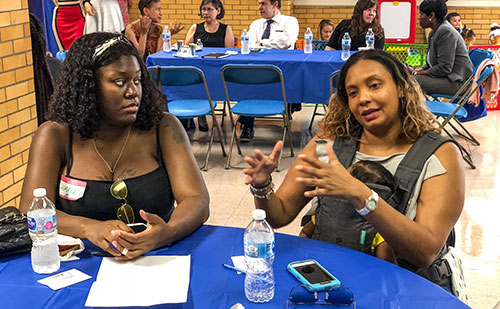Maternal Morbidity and Mortality
The United States has the highest rate of maternal mortality of the developed countries, and the rate has continued to rise over the past two decades. In New York State (NYS) the maternal death rates are alarming, with a rate of 20.6 deaths per 100,000 live births in 2018. Racial disparities are heightened in New York City (NYC) where black women are 8 times more likely than white women to die of a pregnancy-related cause. According to the CDC, at least 60% of all maternal deaths in America could have been prevented. Maternal mortality review committees’ findings indicate that these deaths are not solely caused by medical issues. Unmet social needs contribute to poor maternal health outcomes.
What is Maternal Mortality?
Maternal death or maternal mortality is defined by the World Health Organization (WHO) as "the death of a woman while pregnant or within 42 days of termination of pregnancy, irrespective of the duration and site of the pregnancy, from any cause related to or aggravated by the pregnancy or its management but not from accidental or incidental causes”.
 Through the PICHC initiative, NMPP is working to improve perinatal and infant health outcomes for high-need, low income, Medicaid eligible individuals and their families.
Through the PICHC initiative, NMPP is working to improve perinatal and infant health outcomes for high-need, low income, Medicaid eligible individuals and their families.
According to research, the most common conditions that lead to maternal death are hemorrhage, severe high blood pressure, and venous thromboembolism. In the United States severe maternal morbidity that cause health complications has increased by about 75% over the past decade. Maternal morbidity and mortality relate to higher risk of adverse pregnancy outcomes, like preterm birth and infant death.
Our Target Population’s Health Risk Factors
The families that we serve are clinically high risk. Some of the health and social challenges include obesity, and pre-existing chronic diseases like diabetes and hypertension. These conditions are identified as risk factors by the medical community. The stresses of poor housing, food insecurity, intimate partner violence, and the implicit bias they face when accessing the medical establishment, put them at greater risk for poor birth and health outcomes.
NMPP’s Work to Address Maternal Morbidity and Mortality
Direct Services
• Work to improve direct access to well woman care and maternity care services for high-risk pregnant women and preconception women
• Provide clinical services, including the service of a nurse midwife, for pregnant and pre conception women
• Provide the service of a registered dietician to work one on one with high risk pregnant and preconception women on meal plans
• Provide postpartum doula care
• Connect pregnant women to birth doulas
• Work with post-partum women to ensure timely post-partum visits with their medical providers
• Empower women to advocate for themselves for respectful care at birth
• Educate women to be more knowledgeable of early signs of obstetric complications
• Dissemination of material on maternal issues in various venues and locations through the target area.
Raising Awareness of Maternal Morbidity and Mortality
NMPP has worked with the NYS Department of Health and our local NYC Department of Health to bring awareness of maternal morbidity & mortality to our communities.
• In August 2018, NMPP hosted the New York State Health Commissioner, Howard Zucker, for one of his seven Listening Sessions across New York State. The Commissioner wanted to hear directly from residents who have had adverse birth outcomes.
• In 2018 NMPP participated in the New York State Taskforce on Maternal Mortality and Disparate Racial Outcomes. The Taskforce addressed the landscape of maternal mortality in the U.S. compared to maternal mortality in New York State, as well as the impact of racism on maternal health outcomes among black women.
Members of the Taskforce submitted recommendations to the Governor on ways to reduce racial disparities and preventable maternal mortality and morbidity. Recommendations were informed by Taskforce meetings, and feedback from statewide community listening sessions.
• In June 2019 NMPP hosted one of the communities listening sessions for the New York City Department of Health and Mental Hygiene and Public Health Solutions. These listening sessions will inform the development of a public awareness campaign about safe and respectful pregnancy and childbirth.
Common barriers expressed by participants across all seven of the NYS Health Commissioner’s listening sessions:
• Access to health care (limited facility choice, quality of provider and facility care).
• Poor communication with health care providers (especially their feeling that providers were not listening to them, that they were not given enough time with providers, and that few providers reflected their lived experience).
• Lack of information and education from providers.
• Racism and its impact on the quality of care received.
• Disrespect from health care providers, including support and administrative staff.
• Lack of social support.
Participants’ demands across all seven listening sessions:
• Better understanding of the reasons why black women have poorer pregnancy health outcomes.
• Acknowledgement of the impact of race and racism on those outcomes.
• Action to address the racial disparities in maternal mortality.
• Acknowledgement of the health care systems and practices may perpetuate continued racial inequities.
• Elimination of barriers that prevent women from getting quality health care services.
• Increasing the support needed to help with a healthy pregnancy.
• For all NYS mothers and babies to have the same opportunities to achieve optimal health and positive birth outcomes.
As a result of the Taskforce meetings and listening sessions, the Governor committed $8M over two years in the 2019-2020 Executive Budget to immediately implement the top recommendations made, including launching a Maternal Mortality Review Board, creating an implicit racial bias training and education program for hospitals, investing in community health worker programs, and creating a data warehouse on perinatal outcomes.
